prints, drawings, paintings, web development, blog posts, link to etsy shop
Lake Erie, Colder Water, and Current Study

Over the last month I've been working harder than usual to fix my overall swim form to eliminate my ultra-draggy kick. I made major progress determining the cause(s) but only minor progress fixing it. I want to discuss it at some point, but my long swim in Lake Erie on Saturday was much more interesting to write about, especially the bizarre effect of current that showed up on video.
Saturday was a perfect day for a long swim in the lake. Several days of good weather meant the lake would be (relatively) clean, it was warm and mostly sunny, and winds were calm. My husband Jim accompanied me in his kayak so I could practice my feed routine. Any chop we encountered came mostly from boats and jet-skis in close range. in addition to getting a long swim with feedings, I wanted to learn how to and if I could swim comfortably in colder temperatures for a long period of time. Based on buoy readings, the water was 70 degrees F or just under - perfect for a beginning study. Most cold-water swimmers would laugh at this temperature, but I have to start somewhere, and the water will only get colder from here as air temperatures drop.
Some photos from the morning:
And the Lake Erie surface temperature profile around the time we started:
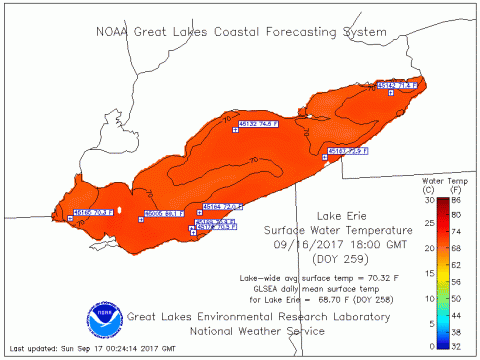
I was able to swim for three hours comfortably. After an hour, I began to fight numbness in my fingers, but I had no sense of cold overall, i.e., my core temperature wasn't dropping. I constantly reminded myself of advice gleaned from open water swimmers' blogs and forums: don't stop for more than 30 seconds to feed, and get used to discomfort in fingers and toes because that goes with the territory. If you can't learn to like it, at least learn to tolerate it. No matter how numb my fingers got, I could still manage a good underwater pull - this was a victory in my book. And it didn't get progressively worse because I found that intermittently making a fist would cause some blood to flow back into my fingers. Surprisingly, my feet and toes remained comfortable through the entire swim (unexpected since I kick very little).
The more interesting and difficult part of the swim resulted from the course we took. We started out heading east, against the current, and turned around after 40 minutes when boat traffic picked up near the mouth of one of the rivers that flows into the lake. When we turned, I looked at my watch to see my average pace was around 1:43 (per 100 yards). We now headed west back to our starting point - which we reached at 1:16. Swimming with the current now was four minutes faster. From the starting point we now went west for 44 minutes - until we hit two hours. And then, when we turned around to head back (east), against the current, it took over an hour to get back to our starting point. It was more than 16 minutes slower coming back on the second out-and-back loop, yet the distance was only about 0.2 miles more than one leg of the first loop.
Here's the route on a Google map:
It certainly felt like the final return leg was against a stronger current that the first, but I had a hard time believing things changed that quickly. So afterwards, I checked the Lake Erie current profile by the hour during the time I was swimming (2:20-5:20) and here's what it showed (note: my swim location was the bottom of the little dip just to the left of the date in the map of Lake Erie):
2:00 pm:
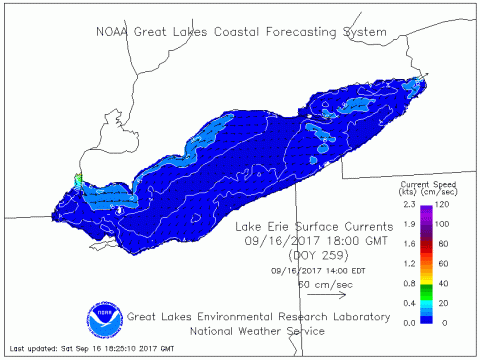
3:00 pm:
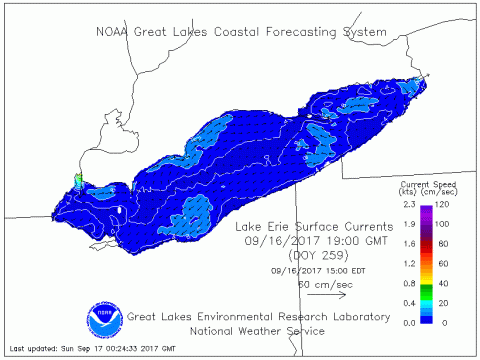
4:00 pm:
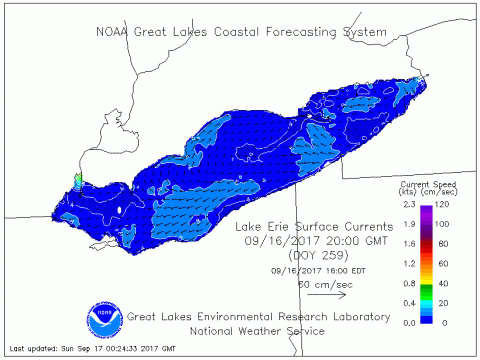
5:00 pm:
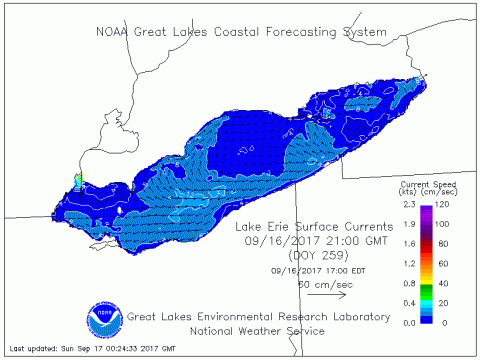
6:00 pm:
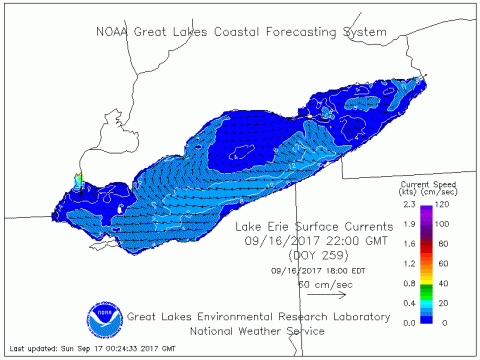
So, there it is, current conditions changed drastically from the start to the finish of my swim.
After the swim, Jim told me something interesting. He said when I was swimming WITH the current, it looked like I wasn't moving at all. But when I was swimming AGAINST the current, it looked like I was going really fast. How could this be so noticeable? Later, while looking at the videos he took from the kayak, I was shocked to see exactly what he had described. Check it out:
I went for a long swim in Lake Erie this weekend. The weather was awesome and I learned more about Lake Erie's changing conditions, how to spending more time in colder water, and the interesting effect of swimming in a current that showed up on video.
tags
archive
- May 2021 (1)
- December 2020 (1)
- September 2018 (1)
- September 2017 (2)
- July 2017 (1)
- June 2017 (3)
- May 2017 (1)
- April 2017 (3)
- January 2017 (2)
- November 2016 (1)
- October 2016 (1)
- August 2016 (2)
- July 2016 (5)
- June 2016 (10)
- April 2016 (1)
- March 2016 (1)
- February 2016 (1)
- January 2016 (2)
- December 2015 (1)
- November 2015 (1)
- September 2015 (2)
- June 2015 (1)
- May 2015 (1)
- April 2015 (1)
- March 2015 (2)
- February 2015 (1)
- January 2015 (1)
- December 2014 (1)
- November 2014 (1)
- October 2014 (2)
- September 2014 (2)
- August 2014 (2)
- July 2014 (2)
- June 2014 (1)
- May 2014 (3)
- April 2014 (1)
- March 2014 (1)
- February 2014 (1)
- January 2014 (2)
- November 2013 (3)
- October 2013 (3)
- September 2013 (2)
- August 2013 (2)
- July 2013 (2)
- May 2013 (2)
- March 2013 (2)
- January 2013 (20)
- December 2012 (18)
- November 2012 (28)
- October 2012 (14)
- September 2012 (1)
- August 2012 (2)
- July 2012 (1)
- June 2012 (3)
- May 2012 (2)
- April 2012 (2)
- March 2012 (4)
- February 2012 (2)
- January 2012 (1)
- December 2011 (3)
- November 2011 (3)
- October 2011 (5)
- September 2011 (2)
- August 2011 (3)
- July 2011 (4)
- June 2011 (6)
- May 2011 (5)
- April 2011 (7)
- March 2011 (6)
- February 2011 (5)
- January 2011 (6)
- December 2010 (3)
- November 2010 (4)
- October 2010 (5)
- September 2010 (9)
- August 2010 (5)
- July 2010 (9)
- June 2010 (4)
- May 2010 (4)
- April 2010 (3)
- March 2010 (2)
- February 2010 (4)
- January 2010 (7)
- December 2009 (3)
- November 2009 (1)
- October 2009 (6)
- September 2009 (4)
- August 2009 (6)
- July 2009 (4)
- June 2009 (13)
- May 2009 (7)
- April 2009 (7)
- March 2009 (10)

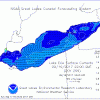


Add new comment